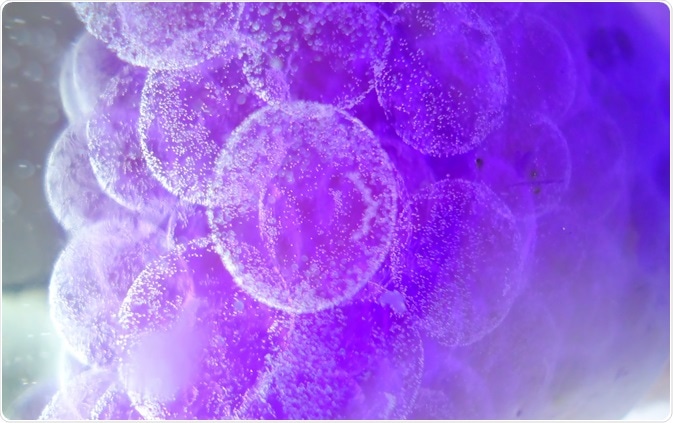Bioactive peptides are short protein fragments (2−20 amino acids in length) that can influence a multitude of bodily functions.
 Credit: businessguide/Shutterstock.com
Credit: businessguide/Shutterstock.com
Bioactive peptides differ from proteins when it comes to length (as proteins usually consist of longer sequences of more than 200 amino acids). They also contain more hydrophobic residues than the average protein and have been shown to be resistant to digestion peptidases.
Sources of biopeptides
Plant sources
Cereal grains such as wheat, barley, rice, rye, oat, millet, sorghum, and corn, are a rich source of bioactive peptides. Wheat and oats have ACE inhibitory peptides, dipeptidyl peptidase inhibitor, and peptides with anti-thrombotic, antioxidant, hypotensive, and opioid activities.
Wheat and rice have peptide sequences which show anticancer activity. Among cereals, wheat and barley showed the highest abundance of peptides with potential biological activity.
Animal sources
Bovine milk, cheese, and dairy products have high amounts of bioactive proteins and peptides. This could provide a possible reason why milk is essential for nutrition in children during the early months after birth. Milk is a rich source of biologically active peptides which are released during digestion.
Consumption of fermented milk which contains bioactive peptides can lower blood pressure in hypertensive patients. Eggs are another rich source of biologically active peptides.
Studies show that fresh egg yolk has higher antioxidant activity than fresh egg white and whole eggs. Boiled egg white hydrolysate showed the highest bioactive peptide activity and a total of 63 identified peptides. Meat and fish derived peptides also show peptides with antihypertensive, antioxidant, antimicrobial and anti-proliferative activities in vitro.
Pharmacological properties of bioactive peptides
For a peptide to be considered bioactive, it should have a physiological effect in a positive manner. This activity of a peptide depends on its amino acid composition, N and C-terminal amino acid, length of the peptide chain, charge of the amino acids, and the hydrophobic/ hydrophilic nature of the amino acid. Some of the pharmacological properties of bioactive peptides are discussed below.
Antioxidant properties of biactive peptides
Oxidation is one of the major disease-causing factors in humans. Peptides derived from milk proteins show antioxidant properties and prevent the peroxidation of essential fatty acids. Digestion of casein also produces phosphorylated peptides with hydrophilic and lipophilic antioxidant activity. Soy peptides show varying degrees of hydrolysis and antioxidant activities.
Antimicrobial properties
Antimicrobial peptides (AMPs) inhibit cell growth and are involved in killing microorganisms, such as bacteria and fungi. AMPs are divided to three families based on their structural features: α- helical linear peptides; disulfide-bridged cyclic and open-ended cyclic peptides; and peptides with a high content of specific amino acid residues (e.g. proline, glycine or histidine rich).
Most AMPs have cationic and hydrophobic properties that lead to easy interaction with anionic bacterial cell wall or membrane. AMPs derived from casein show inhibitory effect against Streptococcus mutans, Streptococcus sanguis, Porphyromonas gingivalis, Streptococcus sobrinus, Sthaphylococcus aureus, Escherichia coli, and Salmonella typhimurium.
Immunomodulatory properties
Proteins and peptides from sources such as egg, milk, soy, and plant sources show anti-inflammatory properties. Ovotransferrin, an egg white protein, inhibits the proliferation of mouse spleen lymphocytes. Peptides from hydrolysates of rice and soybean proteins can stimulate ROS and trigger non-specific immune defense systems.
Cytomodulatory properties
Studies show that cytotoxic compounds which specifically target malignant cell can have anti-cancer effects. It has been proposed that bioactive peptides may possess such cancer protective effects.
Metabolic effects
Changes in metabolism can lead to several conditions, such as diabetes, centripetal obesity, hypertension, and dyslipidemia (elevated triglycerides, dense low-density lipoproteins, and low high-density lipoproteins). Several bioactive peptides are involved in its regulation.
Alpha-glucosidase and dipeptidyl peptidase IV (DPP-IV) are intimately involved in the development of type 2 diabetes (T2D). One of the peptides extracted from egg white show anti-diabetic and α-glucosidase inhibitory properties.
Applications of bioactive peptides
Nutraceuticals are natural-origin substances extracted from fruits, plants, lignocellulosic biomass, and algae that have important health benefits when incorporated into food or pharmaceutical formulations.
Nutraceuticals are receiving great attention due to their effect on human health and diseases. For example, bioactive peptides have been added to infant mild formulas, cheese, and yogurt. Medicinal plants are being increasingly used in food manufacturing because of the presence of natural antioxidants that provides nutritional and therapeutic properties.
Sources:
Further Reading
Last Updated: Feb 26, 2019